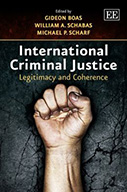International Criminal Justice: Legitimacy and Coherence

Editors: Gideon Boas, William A. Schabas, and Michael P. Scharf
Publisher: Cheltenham, UK, Northampton, MA; Edward Elgar, 2012. 322p.
Reviewer: Roger S. Clark | January 2014
This is an interesting collection of a dozen essays on current issues in international criminal justice. It is a significant product of a project funded by the Australian Research Council. (Most contributors are Australian.) According to the Preface “[w]hile a predominantly legal response to mass atrocity satisfies traditional conceptions of justice, particularly in the milieu of international law, international criminal justice is so much more than this, engaging disciplinary areas such as politics, history, sociology and psychology to name a few.” The authors, lawyers all, endeavor, with varying degrees of success, to achieve such interdisciplinary engagement in an effort to “critique some of the fundamental questions about international criminal justice.”
Gideon Boas sets the tone with his lead chapter, “What is international criminal justice?” He emphasizes historical, political and sociological perspectives, progressing from the Nuremberg and Tokyo trials, through the Tribunals for Former Yugoslavia and Rwanda to the creation of the International Criminal Court. All entities share some similar goals: “to provide redress for the victims of atrocities, to express the moral outrage of the international community, to provide a vehicle of retributive justice and, of course, to stand as a deterrent to those who would repeat such heinous crimes in the future” (p.4-5). The ad hoc Tribunals were different from Nuremberg in that they lacked features of victor’s justice; they also were envisaged by their creator, the Security Council, as contributing to the restoration and maintenance of international peace and security. The International Criminal Court offers prospects of less random country selection than with occasional Security Council action. It also offers some possibilities for restorative justice, an objective to which truth and reconciliation commissions also have something to offer, either in tandem or as an alternative to prosecution. Boas also notes the impossibility of divorcing politics completely from international prosecutions and the rise of the discipline of victimology. He offers thoughts on the psychology of international crime, especially of genocide.
Michael Scharf follows with a chapter that operates on a much lower level of abstraction. It tackles “Order in the courtroom: the unique challenge of maintaining control of a war crimes trial.” He notes the manner in which assorted tyrants have used (whole or partial) self-representation to disrupt proceedings. He draws comparisons with United States examples to develop a typology of the ways defendants can disrupt tribunals they do not regard as having legitimacy. Scharf comes close to acknowledging the intractability of the problem. An accused who abuses his right to self-representation (or co-representation) may be sanctioned. But revoking the right of self-representation “may initiate a number of practical difficulties.” (p. 42). Accused and witnesses may refuse to cooperate with assigned counsel; the accused may go on a hunger strike, or hinder assigned counsel from delivering closing argument on his behalf. The challenge of running a fair trial remains.
The fair trial theme is continued in the chapter by former ICTY judge Lord Bonomy, “Making war crimes trials work – balancing fairness and expedition.” Bonomy is particularly concerned about the enormous time it has taken to complete cases at the ICTY and now the ICC. He believes that the judges should have (and exercise) more control over the size of cases, continue to work with written witness statements (with adequate opportunity for cross-examination and rebuttal), generally streamline proceedings and rein in the right of self-representation. He makes some interesting comments about selection of judges. One paragraph, about the type of persons selected, a mixture of professional judges, international law academics and former diplomats, is worth quotation:
Overall, the balance, which has resulted at the ICTY in fewer than 50 percent of the permanent judges being professional judges, is wrong. Although there is and has been considerable scope for the development of substantive international criminal law, the bulk of the decisions taken by the judges relate to procedure, the admissibility of evidence and the determination of guilt. These are the daily diet of the professional judge. (P. 50).
Australian defense counsel Peter Morrissey complements the judicial view on a fair trial with a stirring chapter entitled “Applied rights in international criminal law: defence counsel and the right to disclosure”. He emphasizes the significance, in order that justice be done, that the “nature and cause” of the charge against the accused and both inculpatory and exculpatory evidence be properly disclosed – and early in the process – so that proper defense investigation may take place. A counsel who achieved a fairly rare trial acquittal at the ICTY, he has some telling comments on prosecutorial lapses. He adds useful comments on the role of victims in ICC proceedings. The defense would, he argues, fail in its duty of due diligence if it failed to treat victims’ advocates as other than hostile opponents. He makes some strong comments in this context on efforts by victims’ advocates to expand the charges in the Lubanga case.
Mark Ierace weighs in on “Complexities in prosecuting international crimes: the ICC Libyan warrants.” The first unanimous reference of a situation by the Security Council led to some quick action in the Office of the Prosecutor. “In a time frame that recalls the confirmation of the indictment against Slobodan Milosevic et al during the Kosovo conflict in 1999, the Prosecutor quickly determined (in contrast to his earlier investigation) that a prima facie case existed against at least three high-ranking government figures” (p. 105). The ICC is unique. “One of the most challenging aspects of the ICC’s uniqueness is that the Office of the Prosecutor (OTP) unlike those of the ad hoc tribunals, must have sufficiently versatile investigative assets to be able to respond to a broad range of types of armed and civil unrest, sometimes at short notice (p. 106).
Gerry Simpson’s “International criminal justice and the past” is the most serious attempt at interdisciplinarity in the collection; it links history and historiography to law. It begins with a quote from Leo Tolstoy: “The theory of the transference of the collective will of the people to historical persons may perhaps explain much in the domain of jurisprudence and be essential for its purposes, but in its application to history, as soon as revolutions, conquests or civil wars occur – that is, as soon as history begins – that theory explains nothing” (p. 123). Simpson appears a skeptic about the international justice exercise, especially as a way of explaining evil through individual responsibility. I particularly enjoyed his cynical Martian invocation: “[t]o a visitor from Mars perusing the historical record as set out in international tribunals in the past 60 years, the impression would be that, with the exception of Bosnian Muslims and Croats tried by the ICTY, war crimes, crimes against humanity and genocide are carried out only by those states (or rebel groups) opposed to the interests of the North Atlantic elite” (p. 144).
Robert Cryer offers a tour through “International criminal justice in historical context: the post-Second World War trials and modern international criminal justice.” He concludes that “[t]he Nuremberg and (to a lesser extent) Tokyo IMTs were the fons et origio of the jurisprudence of modern international criminal law, but the other post-War trials also have a place in our understanding of the law. In spite of the lessons that those trials have to offer, their practices have not led to a systematic approach to the case-law of the post-War period; this is for a variety of reasons, including the fact that the majority of post-War trials were not fully reported” (p.188-9). His overwhelming impression is “the extent to which the forms of justice (or lack thereof) are adopted in an ad hoc fashion, reflecting pragmatic solutions to specific problems rather than principled reflection” (p. 189).
Ben Saul, one of the most sensitive writers on terrorism, discusses “Terrorism and international criminal law: questions of (in)coherence and (il)legitimacy.” His is the chapter which tries hardest to deal with the concepts of legitimacy and coherence that are found in the book’s sub-title. He finds considerable incoherence in the mish-mash of efforts to define the concept, both in the hard law of the terrorism treaties and the efforts of the Security Council, and the soft-law efforts of bodies like the Financial Action Task Force. He is especially critical of the efforts of the Appeals Chamber of the Special Tribunal for Lebanon to articulate a general international law definition of terrorism. He concludes that close analysis of the sources relied upon by the Chamber “demonstrates that its conclusion was mistaken: there is no customary international crime of transnational terrorism” (p.219).
The title of James Potter’s concisely written chapter, “The International Criminal Court and the complexities of international criminal justice” suggests something broader than its actual content. It is devoted to the amendments made to the Rome Statute of the International Criminal Court in 2010 which will eventually make it possible for the Court to exercise jurisdiction over the crime of aggression. Endeavoring to reign in the dogs of war via the criminal law has been an aspiration ever since Justice Jackson’s promise at the Nuremberg Trial that “[t]he record on which we judge these defendants today is the record on which history will judge us tomorrow.” Judging aggression will be complex, but the amendments contain a workable definition of the crime and of the “leaders” who commit it. Thirteen of the necessary 30 ratifications of the amendments are now in hand.
Helen Durham introduces a feminist perspective in “Women and international criminal law: steps forward or dancing backwards.” While arguing that the “grand international criminal law and justice ‘project’ as it relates to women is not coherent” (p. 254), she nevertheless finds that significant achievements “such as the jurisprudential developments clarifying sexual violence and rape as serious international crimes, the inclusion of wider ‘gender’ elements within the Rome Statute of the International Criminal Court (‘Rome Statute’) . . . and other ways in which prosecutions have assisted and supported women in post-conflict societies (such as by answering question about missing loved ones), possess legitimacy beyond questions of the consistency of application and understanding” (p.254). Her chapter, acknowledging that the glass is at least half full, serves as a reminder that international criminal law is a useful tool, but cannot solve all the problems of women’s security world-wide.
Sam Garkawe asks: “Have recent changes designed to benefit victims of international crimes added to the legitimacy of international criminal justice?” He offers a comprehensive tour of developments since the UN’s landmark 1985 Declaration of Basic Principles of Justice for Victims of Crime and Abuse of Power to the inclusion of some of the Declaration’s in the Rome Statute of the International Criminal Court. He tries to discover how it has all worked out both at the domestic and at the international level. The ICC is still floundering with how exactly to involve potentially millions of victims in the judicial process (or as beneficiaries of the programs of the Court’s Fund for Victims) and how to assess the appropriate amounts of reparation (in the unlikely event that an accused is discovered still in possession of funds). He considers whether non-prosecutorial activities, like truth and reconciliation processes, might add more legitimacy in the eyes of victims than court proceedings themselves.
The volume concludes with a terse chapter by Geoffrey Skillen, formerly a lawyer with the Australian Defence Force and a significant voice in the negotiation of the Rome Statute. His basic message is a very important one, given opposition to the ratification of the Rome Statute in some military circles: “a well-trained and disciplined military force that exhibits a commitment to the observance of IHL has nothing to fear from international criminal justice and should adopt a ‘business-as usual’ approach” (p. 304). His hard-headed approach to the subject provides a down-to-earth conclusion to a very interesting volume.
Roger S. Clark, Professor at Rutgers School of Law, Camden


